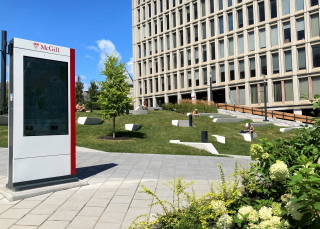Exterior and green spaces are one of the most defining elements of a university’s campus. They perform many important functions as connectors, activity spaces and defining structural features, and play an essential role in making the campus fit for a sustainable future.
Green spaces

The lower downtown campus is now a pedestrian zone with restricted vehicle access and limited parking, resulting in a safer, more physically active environment. This has included the removal of 150 parking spaces by McGill.

More recently, the Leacock Building west-side terrace was transformed into a welcoming exterior amphitheatre that offers 15% more green space than previously.
New Vic
The University's flagship project for the next decade, the New Vic, will provide new green spaces and direct access to the mountain for all Montrealers and visitors to enjoy. It will prolong the city's Promenade Fleuve-Montagne by creating a new entry point to the site and connecting the downtown campus to the Mount Royal park. By removing the two more recently-built pavilions M & S (while preserving those with heritage value), McGill will further extend the mountain’s presence into the city by reducing the overall building height by 15m and restoring the view of the mountain, allowing it to be visible from the intersection of University and Pine avenues for the first time in 70 years.
Rainwater management
Rainwater management plays an important role in maintaining the sustainability of campuses. Large amounts of impermeable surface increase flooding risk and result in a host of negative impacts on the environment while also creating a burden for municipal infrastructure such as sewers and roadways.
Effective rainwater management represents an important climate change mitigation measure as the potential for rainfall increases. To address this issue, construction projects must capture rainwater on site during a storm, and slowly release the water into the municipal system to avoid overwhelming it.
McGill’s Master Plan sets out to:
- Minimize the amount of impermeable surfaces,
- Ensure that each sector of campus (or “neighbourhood”) has sufficient water management measures in place, and
- Prioritize rainwater management techniques that are sustainable, natural and plant based.
Green roofs

The Bellini Life Sciences Building has a green roof, which reduces energy consumption while also mitigating the heat island effect of the five-floor building. The New Vic will include several green roofs.
Active transportation
Walking and cycling are very common modes of transportation used by the McGill community; they account for approximately 35 percent of all trips to campus. Therefore, it is important that McGill campuses ease movement for pedestrians and promote active modes of transportation.
McGill’s Master Plan supports the University’s ongoing transition to pedestrian-oriented campuses that are also supportive of cycling. The plan seeks to consolidate and limit vehicular traffic while also improving pedestrian movement on campuses and providing additional bike parking.
Objectives include:
- Prioritizing pedestrians over vehicles at all our gateways.
- Facilitating access to buildings and navigation on campus by developing a pedestrian network that is safe, accessible and leads to the main accessible entrances of buildings, including at Macdonald Campus.
- Maintaining the shared space policy for the campus circulation network by prioritizing cycling second only to pedestrians.
- Continuously increasing bike parking to support the ongoing adoption of cycling as a mode of transportation for commuting.
- Implementing bike parking solutions that are durable and strategically placed.
- Cap the amount of parking spaces on campus to support a shift in travel behaviour toward more sustainable modes of transportation.
- Redesign some areas to eliminate car-centric design features and restrict vehicle access and circulation, including at Macdonald Campus.
